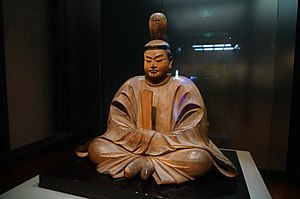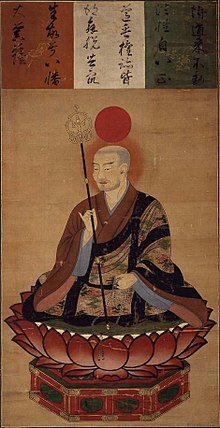Hachiman

In Japanese religion, Yahata (八幡神, ancient Shinto pronunciation) formerly in Shinto and later commonly known as Hachiman (八幡神, Japanese Buddhist pronunciation) is the syncretic divinity of archery and war,[1][2][3] incorporating elements from both Shinto and Buddhism.[4]
In Shinto religion, he is mortally Emperor Ōjin (応神天皇, Ōjin Tennō) by birth who reigned in the 3rd–4th century and the son of Empress Jingū (神功皇后, Jingū-kōgō), later became deified and identified by legend as "Yahata-no-kami" meaning "Kami of Eight Banners", referring to the eight heavenly banners that signaled the birth of the divine and deified emperor, and is also called Hondawake (誉田別命). His messenger is the dove, symbolizes both the bow and arrow found in samurai banners associated to him where he is called "Yumiya Hachiman" (弓矢八幡).
Since ancient times Hachiman has been worshiped by farmers as the god of agriculture and by fishermen, who hoped that he would fill their nets with many fish.
During the age of the samurai, descendants of both samurai clans, Seiwa Genji (清和源氏 Seiwa Gen-ji, a line of the Minamoto clan descended from Emperor Seiwa) and Kanmu Taira (桓武平氏 Kanmu Taira'u-ji/ Hei-shi/ Hei-ji, a line of the Taira clan descended from Emperor Kanmu) honored Hachiman, from which the tradition is derived nationwide in which samurai clans (武家 "buke" in Japanese) honor Hachiman as the deity sacred to them. His other roles include determining a samurai's fate—i.e., whether they are a success or failure in battle; controlling and protecting the martial arts; and proclaiming the victory of an army.
Although often called the god of war, he is more strictly defined as the tutelary god of warriors.[4][5] He is also the divine protector of Japan, the Japanese people and the Imperial House.
Summary of Hachiman
In the present form of Shinto, Hachiman is the divine spirit of Emperor Ōjin. Emperor Kinmei (欽明天皇, Kinmei-tennō) in his Regnal Year 32 (571 AD) decreed that the deified Emperor Ōjin was revealed for the first time in the land of Usa (宇佐の地)—the present-day city of Usa, in Oita Prefecture—where he became the patron deity of this city, along with a lesser Shinto female deity called Himegami (比売神) and the Emperor's mother, Empress Jingū. This trio, known as Hachiman Mikami (八幡三神) is enshrined there.
Amongst the Hachiman Mikami, there are many shrines that enshrines other figures apart from the trio, like
Himegami
The three Munakata goddesses (宗像三女神 Munakata Sanjoshin) born from the divination ritual Ukehi or Ukei (宇気比, 誓約, 祈, 誓, 誓占, lit. "pledge divination") between the goddess Amaterasu and the god Susanoo - that is Tagitsu-hime (多岐津姫命), Ichikishima-hime (市杵嶋姫命) and Tagairi-hime (多紀理姫命) - is said where they descended from the heavens as the "Three Pillars of Usanoshima (宇佐嶋) of the ancient province of Tsukushi (筑紫)", located in a temple complex on Mt. Omotosan (御許山) in Usa.
The Munakata goddesses are thereby the
Himegami (比売神) is thought to be the consort or aunt of Hachiman, whereas Tamayori-hime (玉依毘売命 or 玉依姫尊) possibly and perhaps as the mother viewed by opinion aforementioned. Since the description of Hachiman as the Emperor Ojin appeared in the "Digest Record of Todai-ji Temple (東大寺要録 Tōdai-ji Yoroku)" and "Records of the Age of the Gods from the Sumiyoshi Grand Shrine (住吉大社神代記 Sumiyoshi-Taisha Jindaiki), the practice of merging Emperor Ōjin into Hachiman is estimated to have begun in the Nara Period or the Heian Period.
There are also different theories and opinions concerning the goddesses Amaterasu and
Empress Jingū
Emperor Ojin was already destined to ascend the throne from the moment in the womb of his mother and Empress, is called "Emperor in the Womb", is based and interpreted sometimes in her belief as being the "mother deity" to the child-to-be who would be deified. The Three Munakata Goddesses, the Three Sumiyoshi Gods (住吉三神 Sumiyoshi Sanjin) and the goddess Amaterasu who were revered by the tribal clan Munakata-shi due to their aid in the "Conquest of the Three Kingdoms (of Korea)" is also worshiped in various places. It is said by tradition in commemoration after the conquest, Empress Jingu set up eight big military flags on Tsushima (対馬) which then became the origin of the name "Hirohatano Yahata Ōkami (広幡乃八幡大神)", also the origin of the name "Yahata (八幡)" to the Empress' son, the then-emperor Ojin.
Imperial Ancestor and Deity to the Imperial Family
The founding of Konda Hachiman-gū (誉田八幡宮) Shrine at
Syncretism of Hachiman in between Shinto and Buddhism

After the arrival of
This transition happened when the Great Buddha of
Then in the "First Year of the Era of
Thereafter in the Heian Period, veneration of Shinto shrines of Hachiman have been received and gathered throughout the nation by the samurai clans Seiwa of the Genji clan (清和源氏) and Kanmu of the Taira clan (桓武平氏). When the theory of syncretism has spread during this period, Hachiman is depicted to represent a Buddhist monk and is then called Sogyō Hachiman (僧形八幡神, "Buddhist Priest-Form Hachiman").
Worship of Hachiman by the Samurai

Because Emperor Ōjin was an ancestor of the
Following the establishment of the Kamakura shogunate, the worship of Hachiman spread throughout Japan among not only samurai, but also the peasantry. There are now about 2,500
Hachiman's
See also
- Hachiman shrine
- Tōdai-ji Hachiman
- Kamikaze (typhoon)
- Minamoto no Yorinobu
- Minamoto no Yoriyoshi
- Bishamon -- Shinto-Buddhist God of War
- Hitogami
References
- .
- ISSN 0018-2710.
- ^ "Hachiman & Hachimangū Shrines".
It was only later, sometime in the 9th century, that the deity became associated with Emperor Ōjin, and later still that Hachiman became worshipped as the god of archery and war, ultimately becoming the tutelary deity of the Minamoto clan and its famed warrior Minamoto Yoritomo 源頼朝 (1147–99), founder of the Kamakura shogunate
- ^ a b Scheid, Bernhard. "Hachiman Shreine" (in German). University of Vienna. Retrieved 17 August 2010.
- ^ a b Motegi, Sadazumi. "Shamei Bunpu (Shrine Names and Distributions)" (in Japanese). Encyclopedia of Shinto. Retrieved 23 March 2010.
- JSTOR 2384320.
- ISBN 978-1-57607-467-1.
Further reading
- "Hachiman" – Ancient History Encyclopedia
- Bender, Ross (Summer 1978). "Metamorphosis of a Deity: The Image of Hachiman in Yumi Yawata". JSTOR 2384124.
- Bender, Ross (1980). The Political Meaning of the Hachiman Cult in Ancient and Early Medieval Japan (Ph.D. thesis). New York: OCLC 80794660. Archived from the originalon 2015-04-14. Retrieved 24 June 2020.
External links
 Media related to Hachiman at Wikimedia Commons
Media related to Hachiman at Wikimedia Commons



